Iran has a lot more to offer than only the famous places like Isfahan, Shiraz and Persepolis. Let us take you to the secrets of Iran, remote desert villages, hidden valleys, Kurdish mountain villages, bizarre islands, wonderful national parks, isolated churches etc. Here are our suggestion list for Best off the beaten path places in Iran – hidden gems to explore!
Historical off the beaten path sights in Iran
Iran is a treasure trove of history, boasting numerous off-the-beaten-path historical sites that often go unnoticed by tourists. These hidden gems offer a unique glimpse into the rich tapestry of Persian civilization. These off-the-beaten-track historical sites in Iran offer a captivating journey through time, providing travelers with a deeper understanding of the country’s rich heritage and the opportunity to explore its lesser-known treasures.
Alamut Castle
Hidden in the middle of majestic Alborz mountain range, Alamut valley is an area full of beautiful villages and imposing castles, all reminders of the Assassins, warriors from the 10th and 11th century. There are about 20 castles in this area, the most famous one is the famous Castle of Alamut. It’s a great area for hiking, with longer trails leading over the mountains to the Caspian Sea.
Alamut Castle stands atop a dramatic cliff, guarding the secrets of the medieval Ismaili sect. This fortress played a pivotal role in the history of Iran and was once the seat of Hasan-i Sabbah, head of the Assassins.
Read : Alamut Castle – Mysterious Fortress of Assassins
To reach Alamut Castle, you have to take the Karaj-Qazvin highway from Tehran, before reaching Qazvin, there is a region called Mo’alem Kalaye, 85 km from this city. The road is very scenic and winding. It takes 1 to 4 hours to reach the Alamut Castle.
Babak Castle of Kaleybar
Located near the village of Kaleybar, the imposing Babak castle is one of the most famous castles of Iran . It rises high above the landscape. It is a steep climb to the castle, which is a symbol for the proud Azeri Turks in Iran.
According to the archaeological investigations, the fortress dates back to the Sasanian empire era, but due to its special location and difficult access, it has been used in various subsequent periods. In this place, an Iranian warrior named Babak Khoramdin fought for twenty years (from 816-817 AD to 837 AD) against the invasion of the Abbasid caliph al-Mu’tasim, and finally he was defeated and brutally killed in an unequal war.
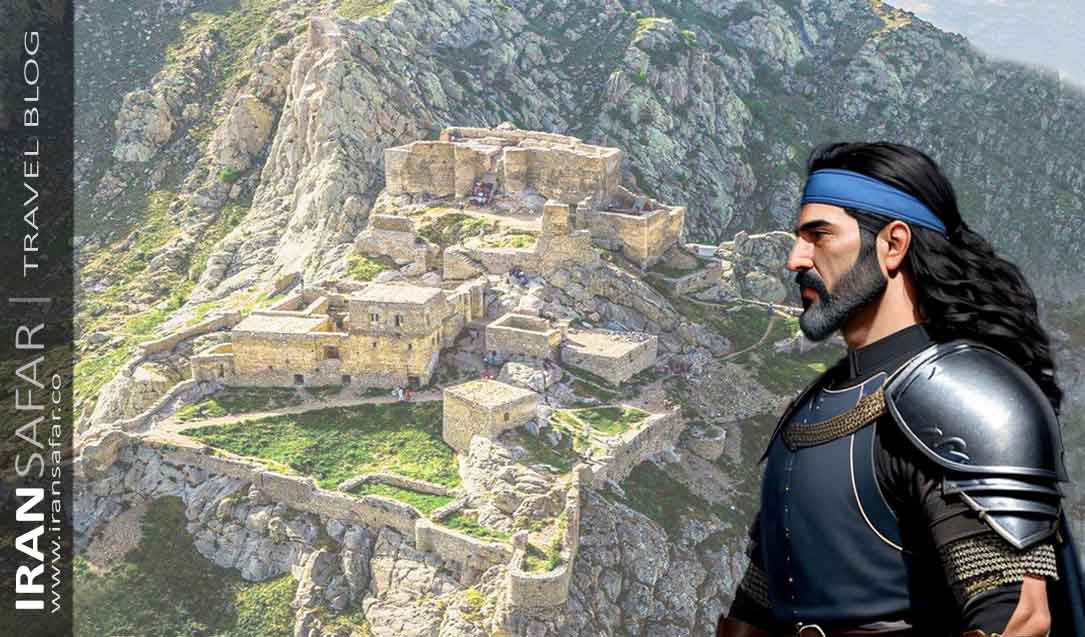 Babak Castle, Kaleybar, Iran
Babak Castle, Kaleybar, Iran
Qara Kelisa
According to historical records, it was during the Parthian period that Christianity and the call to this religion was formed in Iran and people started to convert. Little by little, the places of worship appeared in every corner of Iran, each one built in a different way. Churches, as a symbol of the Christian world, were decorated as beautifully as possible and displayed unique effects of architecture. Today, there are many churches in Iran, and some of them are recognized in the list of national or world heritage.
“Monastery of Saint Thaddeus” or “Qara-Kelisa” is located 20 km from Chaldaran city, in West Azarbaijan province of Iran.
Since parts of the facade are made of black stone, a relatively new name Qara Kelisa (meaning black church in Turkish) is also applied to this place.
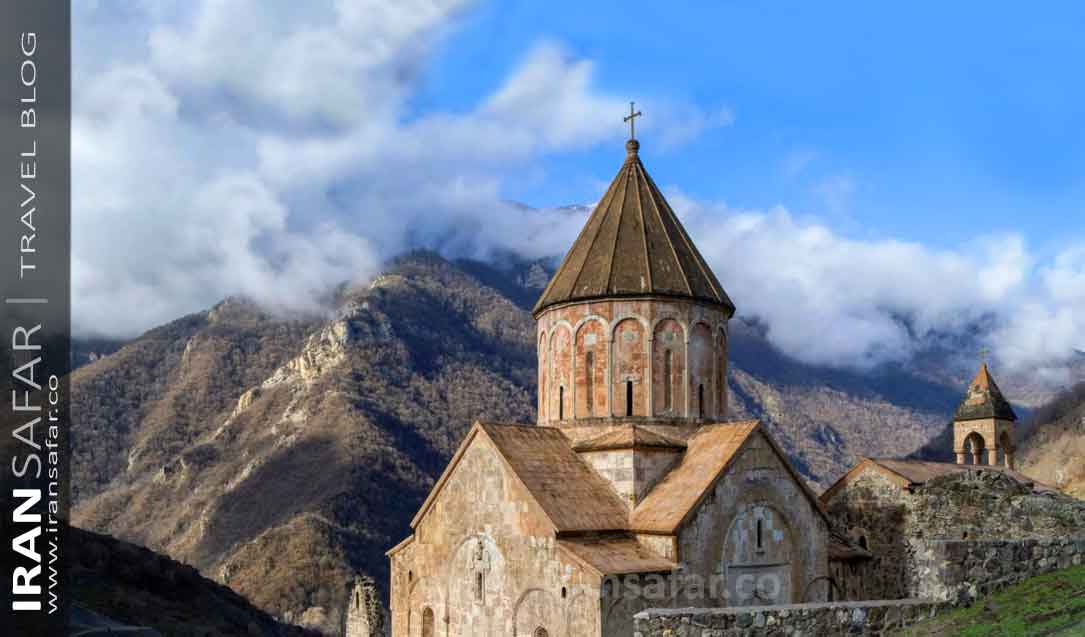 Qara Kelisa, Armenian Church, Iran
Qara Kelisa, Armenian Church, Iran
The apostles (also known as Jude) and saint Bartholomew are traditionally believed to have been the first to bring Christianity to to the Kingdom of Armenia during the Parthian Empire. They are therefore venerated as the patron saints of the Armenian Apostolic Church. Linked to this tradition is the Saint Thaddeus Monastery (now in Iran) and Saint Bartholomew Monastery (now in southeastern Turkey) which were both constructed in what was then Armenia. Thaddeus and his companions were persecuted and killed along with the daughter of the king “Santruq” who was named “San Dokht” after spreading the religion of Christ in 65 AD.
The structure of this monastery was built by a saint named “ ” and its historical value is “the first cathedral in the world” which Christians believe was the first time the companions of Christ built it in the world.
From Tabriz, drive towards Sufiyan and then Marand. Leave Qara Ziauddin behind. 20 minutes after the village of Khizrlu, turn towards Shut on the highway. Turn left at the next road, the village of Qara Kesila is at the end of this road. You have to drive for about 3 hours from Tabriz.
From the city of Urmia, after passing Salmas and Khoy, you will reach Qara Ziauddin. The rest of the route is the same as the Tabriz route. It takes 3 hours to reach the destination from Urmia.
Also Read : 5 remarkable churches in Iran
Shapur Cave
The historical Shapur cave is located in Fars province, Kazeroon city, 4 kilometers away from Bishapur site and at the end of a gorge called Tang-e Chugan. It is one of the most important historical caves of Iran and supposedly one of the religious and ritual places of the region before the Sassanid era – where some ceremony would have taken place.
Shapur cave is formed on a cliff side in Tang-e Chogan in the shape of a semicircle. The cave mouth is 30 meters wide. It is very deep and not possible to be fully explored in a short time. Being originally a natural stalagmite column, a 7-meter high statue of Sassanid king Shapur I is located at the mouth of the cave, as a masterpiece of Sassanid era sculpture, which was created by carving mineral stones. Parts of it have been destroyed, but it still dazzles the eyes of tourists with its grandeur and dignity like a guard on top of the mountain.
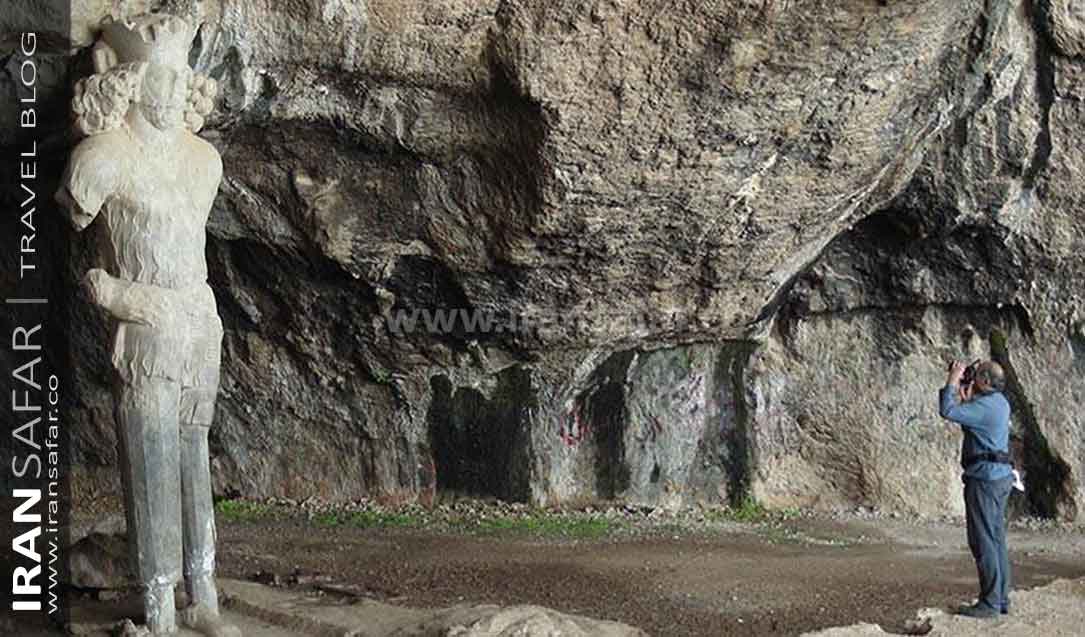
The statue wears a crown and a mass of twisted hair protrudes from under the crown. The body of the Shapur statue is muscular and narrows from the top to the bottom. In the original design, Shapur had his right hand on his waist and his left hand on his sword; But now the statue does not have its original shape due to vandalism.
Go from Shiraz to Bishapur. Both the old road and the new road of Kazeroon will take you to Bishapur
After you reach Bishapur, continue the route to Tang-e Chogan. After 5 kilometers, you will reach the village of “Kashkuli“. Park your car in the village and continue hiking for an hour. You can get help from locals to reach the cave; Of course, the path of the cave is straight and has indicator signs.
Archaeological off the beaten path sites in Iran
Iran’s off-the-beaten-track archaeological sites offer a captivating journey through the human history, often overshadowed by the country’s more famous landmarks. These hidden treasures unveil the depth and diversity of Iran’s historical legacy.
Kurangun bas-relief
One of the largest and oldest bas-reliefs in the world, called the Korangon relief, is located 10 kilometers southwest of Noorabad Mamsani city, on top of a cliff overlooking the Fahlian river. In 1924, the Korengon relief was scientifically explored by the German Professor Ernst Herzfeld and its historical date was estimated to be 2400 BC, a millennium before the arrival of the Aryans to the Iranian plateau. A pair of gods and goddesses surrounded by rows of worshipers. The god and goddess with their horned hats are sitting on a throne made of snake trunk – apparently snake worship was common in the region such as in the ancient India before the appearance of Aryans.
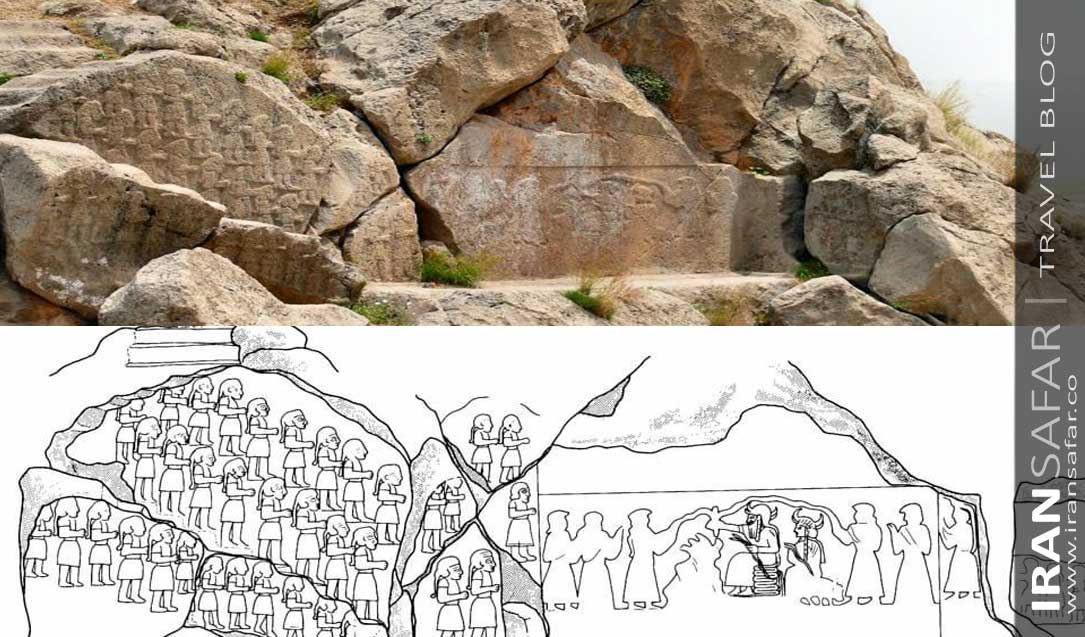
The relief of the Elamite Korangun is completely native and some of its details show the Sumerian origin (a government in 3000 BC Mesopotamia). For example, the crown carved on the head of the god and the goddess with horns separated from each other was seen a lot in the Sumerian period before the Akkadian period (a tribe of Benisam who lived in the Lower Chaldea about 3000 BC). The deity is holding a vessel full of water of life in her hand and has flowed it towards the ranks of his worshippers. There are more than 40 worshipers of this bas-relief, some of whom fell to the bottom of the valley due to natural factors in the past and probably fell into the Fahlian river overlooking the bas-relief, or were buried under the sand of the river. or the water of the river took them with it and destroyed them. So far, a copy like the Korangon relief has not been found either in Mesopotamia or in the ancient places of the ancient world. Almost a second example or a second version of the Korangun relief can be seen in Rostam Naqsh near Persepolis, the burial place of Achaemenid kings, which stood until the second half of the 3rd century AD, but later it was erased and Bahram II’s face was engraved on it. A part of this faded work, which can be seen in the right corner of the image of the Rostam relief, is still showing the torso of snakes and two goddesses in Sumerian clothes on the bed, and also a female figure similar to the women found in the Korangon relief of Rostam city can be seen, which is completely intact. Therefore, this role must have been installed at a time close to the Korangon Elamite sculptures of Rostam city, i.e. around 2400 BC. However, the prominent role of Korangun was an important Elamite place of worship in this place, and this role proves that the influence and civilization of Elam at that time had expanded to the limits of the cities of Mamsani, Rostam, Marvdasht and Persepolis.
The city of Izeh
It is fair to say that Izeh is not included in any of the classic or routine plans for traveling to Iran, but we introduce it as an off-the-beaten-path archaeological paradise! According to some researchers, this city was originally called “Anzan” in the third millennium BC and was the capital of Anzan state. Izeh can also be considered a modified form of Elamite “Anzan”. In Izeh there is a pack of historical places to see, off the beaten path of course!
Eshkaft-e Salman Cave
Tarisha Temple or Eshkaft-e Salman cave has the largest inscription written in Elamite cuneiform. There are four reliefs in here, two of which can be seen inside the cave and the other two outside the cave. The largest cuneiform writing from the Elamite period is found in this cave, which was left from 11 -12th century BC. For the first time, the presence of a royal woman, side by side with a man, was seen in the reliefs of this cave.
Relief I
Carved inside a rectangular panel about 8.5 m above ground level, Relief I depicts two men, a boy, and a woman standing in profile oriented toward the cave making worship gestures before a fire stand. It shows the prayer ceremony of Hanni, the local king of Ayapir, along with his wife, his son and his chief minister Shotruru. This relief has an inscriptions in Elamite cuneiform script.
Relief II
The second relief of Eshkaft-e Salman is similar to the first one. The only difference in this carving panel is the absence of the minister. Similarities with inscribed brick panels at the city of Susa advocate a 12th-century BC date for the first two reliefs.
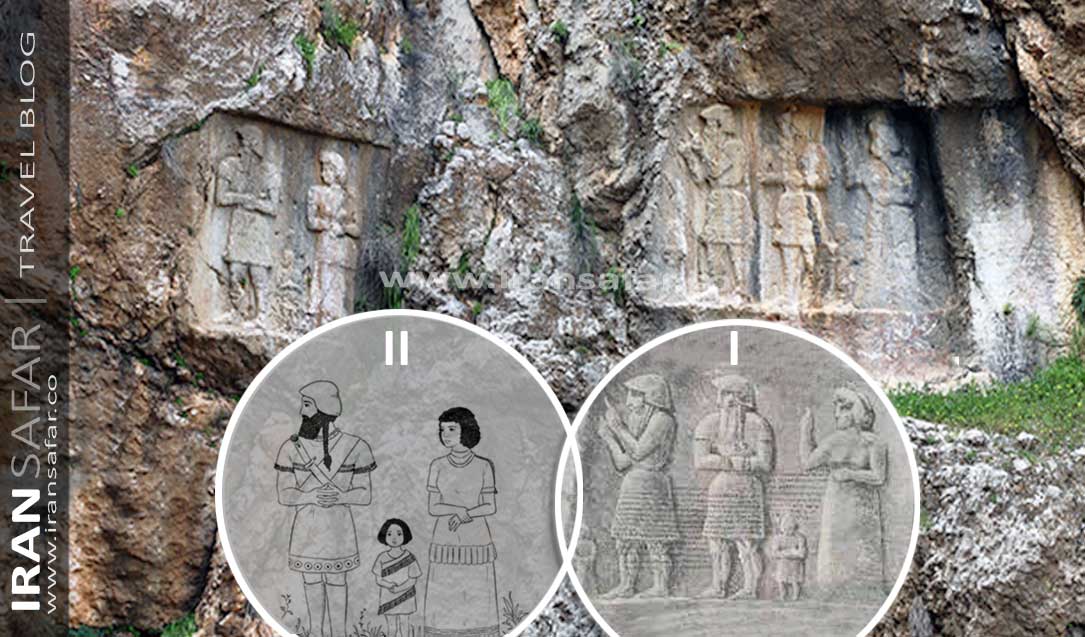 Eshkaft-e Slaman Cave, Elamite Bas-reliefs
Eshkaft-e Slaman Cave, Elamite Bas-reliefs
Relief III
Relief carved inside the mouth of the cave depicting a man standing in profile oriented toward its interior. He wears a short-sleeved garment with a short bell-shaped skirt and raises the hands in front of the face with index fingers extended in a pointing gesture. A long inscription of Hanni was added to his right and a large, blank panel to his left. The date of this relief could be as early as the 11th century and as late as the 7th century.
Relief IV
Among the works left in Eshkaft Salman bas-reliefs, IV is the most damaged and nothing accurate can be obtained from it. However, with what was found in Kul Farah site, it can be assumed that one of the gods was depicted in this relief. It depicts a man standing on a small pedestal oriented toward the cave’s interior. He wears a short-sleeved garment with a long skirt and clasps his hands together at the waist. A 12th to 11th century BC date seems most appropriate for this relief.
Kul-e Farah
Kul-e Farah carving panel is an archaeological site and open air sanctuary situated in an area called Tang-e Kul Farah, 7 km northeast of Izeh. Six Elamite rock reliefs are located in a small gorge marked by a seasonal creek bed on the plain’s east side of the valley, near the town of Izeh in Khuzestan.
The Kul Farah bas-relief contains 6 reliefs that date backs to the old Elamite period. According to the carved images and remains such as graves, water channels, special structures and observation areas, it is suggested that this place was the temple of Narsina (one of the Elamite gods).
Gonbad-e Kavus
Gonbad-e Kavus or Gonbad-e Qabus is an old city in Golestan province. Once called Gorjan, it was the capital of Iran, also an important city on the Silk Road a 1000 years ago. The most important dynasty that ruled in Gorjan was Al-e Ziyar dynasty from which a massive brick tower remains. The Gonbad-e Kavus tower is considered the tallest brick tower in the world. It is one of the tourist attractions in the town.
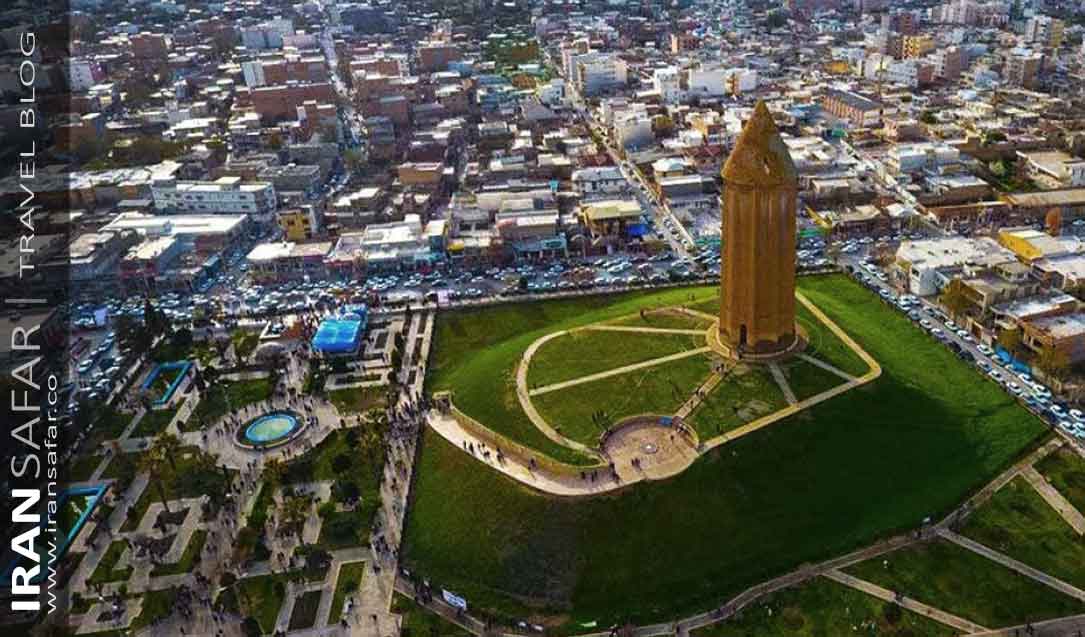
This magnificent tower is built on a hilltop that is about 15 meters high from the surrounding land, and its building consists of three parts: the foundation, the body and the dome, which together are 55 meters high. Thus, including the height of the hill, this tower is about 70 meters higher than the surface of the surrounding land, which adds to its splendor.
Although most archaeologists often consider this building to be the tomb of king Amir Qabus, some historians have thought that this building was built as an observatory. Because in the excavations of this building, no trace of human remains was found.
Some other Iran’s top off the beaten track places that you might like are as per below:
Tepe Sialk: In Kashan, Tepe Sialk is one of the world’s oldest ziggurats, dating back over 5,000 years. This ancient mound reveals insights into the Elamite civilization, with its mud-brick structures and artifacts providing a glimpse into prehistoric Iran.
Chogha Zanbil: Located in Khuzestan Province, Chogha Zanbil is an ancient ziggurat built by King Untash-Napirisha around 1250 BC. This UNESCO World Heritage Site is a remarkable example of Elamite architecture and religious practices.
Takht-e Soleyman: Situated in a remote region of northwest Iran, Takht-e Soleyman is an archaeological complex encompassing a 2,500-year-old Zoroastrian fire temple, a sacred lake, and ancient fortifications. This site offers a profound connection to Iran’s Zoroastrian heritage.
Bishapur: In the heart of Iran’s Fars Province lies Bishapur, an ancient city founded by the Sassanian King Shapur I. The city features ruins of palaces, a temple, and a rock relief depicting the king’s victories.
Tureng Tepe: Located in northeastern Iran, Tureng Tepe is an excavation site revealing the remains of a Parthian settlement. Its artifacts and structures provide insights into the Parthian Empire’s culture and daily life.
These off-the-beaten-track archaeological sites in Iran invite intrepid travelers to explore the lesser-known chapters of the country’s history. With their ancient ruins, enigmatic ziggurats, and historical artifacts, these sites offer a deeper understanding of Iran’s rich and diverse heritage, away from the typical tourist crowds.
Natural off the beaten path places in Iran
Iran’s top off-the-beaten-track national attractions are hidden gems that often elude the typical tourist itineraries. While the country boasts famous sites like Persepolis and Isfahan, there are lesser-known treasures that offer a more intimate and authentic experience of Iran’s rich natural heritage.
These off-the-beaten-track national attractions in Iran promise a deeper connection with the country’s history, culture, and natural wonders. Exploring these hidden gems allows travelers to discover the lesser-known facets of Iran, providing a richer and more authentic travel experience.
Hormuz Island
A small and hot island in the Persian Gulf. But the nature of this small island is beautiful. At least if you are open to the whims of Mother Nature. The island is a geological miracle, consisting of lunar landscapes in the most diverse shapes and colours. You can visit salt mountains and salt caves full of imposing crystals. Look out from impressive cliffs over deserted beaches and the Persian Gulf. Visit valleys with jagged rock formations that take on all kinds of shapes, not surpringly named the ‘Valley of Statues’. Then there’s an enchanting red coloured beach, and the island is a haven for Iranian backpackers as well, giving it a very mellow vibe.
Also Read : Qeshm Island
Mesr, Dasht-e Kavir desert
Picture a small, one-way street village, surrounded by sand dunes, in the middle of the desert, far away from everything; welcome to Mesr.
This is a great place for dune bashing, camel treks, hiking on sand dunes, or just simply enjoy the beauty of the desert and the skies full of stars at night in pure silence. It has a lot of friendly eco-hotels.
Golestan National Park
The oldest national park of Iran is in Golestan on the Northeast of the country. It is home to bears, jackals, gazelles, deer, boar, ibex and the Persian leopard. The latter is the largest leopard species in the world, and also one of the rarest. You can also learn more about the culture of the Turkmen nomads who roam the region and live in yurts.
Also in Golestan you will find the wonderful rolling hills around Khaled Nabi.
Also Read : Iran’s natural attractions
Off-the-beaten-path cultural attractions in Iran
Kurdish Mountain Villages
In the west of Iran lies Kurdistan, a rugged mountain landscape with beautiful alpine villages and extremely hospitable people. There you find beautiful mountain villages such as Howraman or Uraman and Palangan. The friendly Kurds are recognizable by their baggy trousers and their own culture and traditions.
Also Read – Iran Ethnic Groups
Minab Thursday market
Once a week the small town of Minab comes alive. Every thursday there is a market, a great place to see the Bandari culture. These are Arabic people living on the Iranian Gulf. The women still wear traditional masks, which are sold on the market as well. If you want to buy a camel, goat or some sheep, this is a great place too.
Nay Band
Perhaps the most beautiful desertic village, and certainly one of the most beautiful villages in Iran, also one of the most isolated ones, is Nay Band. Like an impregnable fortress, this village is located on the slopes of a mountains overlooking the Lut desert. Covered with wheat and barley fields, citrus groves and beautiful groves, Nay Band is like a green island in the heart of the desert.
The village is located near the city of Tabas, south Khorasan province. In order to get to the village, you should get on Tabas-Kerman road from the south of Tabas and pass Dihok and Zenughan until you see the Nay band sign on the side of the road. From this point, you need to drive a few kilometers to reach the village.
Also Read – 10 most fascinating villages of Iran
Armenian Churches around Jolfa
In the borderland with Armenia and Azerbaijan you will find ancient Armenian churches, all on isolated spots in rough mountain valleys. The area used to be part of the great Armenian empire. Most churches and monasteries you will find around the bordertown of Jolfa.

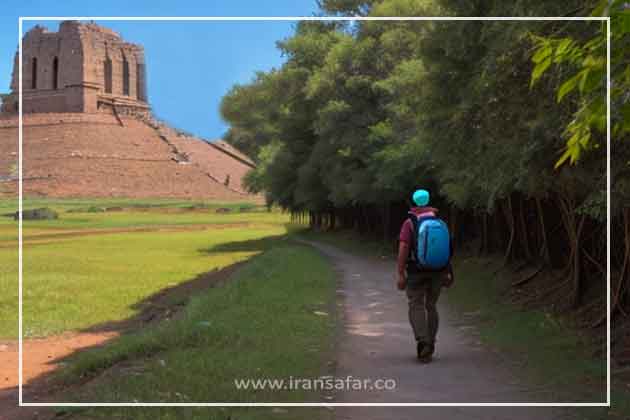

Comment (0)